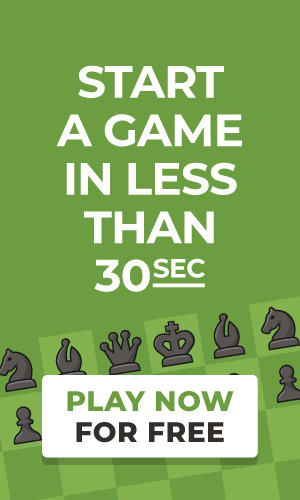
Back-Rank Mate
In chess, keeping your king protected behind your pawns and away from the center of the board is almost always a good idea. But did you know that this strategy can backfire? That is why you should always keep an eye out for the back-rank mate.
What Is A Back-Rank Mate?
In chess, a back-rank mate is a checkmating pattern that happens when a player delivers checkmate by attacking the back rank of their opponent (first rank for White, eighth rank for Black). For this checkmate to be possible, the squares in front of the king must be blocked by its own pieces.

Back-rank mates can also happen with the help of attacking pieces.

Check out the video below by IM Kostya Kavutskiy about the back-rank mate.
Why Is The Back-Rank Mate Important?
The back-rank mate is one of the most basic checkmating patterns in chess. Since castling is usually the best way to keep the king safe, the pawn structure that allows for this kind of mate often appears on the board.

Spotting back-rank weaknesses can be a powerful weapon in a player's arsenal. You can see an example of how to explore this weakness in the position below.

In this game played between IM Andreas Moen and GM Veselin Topalov, Black saw that White's back-rank protection is hanging by a thread. If only the white queen's access to back rank could be blocked, Topalov could sacrifice his queen to deliver mate. He found a smart way of distracting the white queen by playing Bh6. Then Moen took the bishop to avoid losing the rook, but that allowed Topalov to deliver the game-ending blow.

Checkmating is not the only result you can achieve from this weakness. Exploring the possibility of a mate can also lead to material gain. You can see an example in this game between GM Svetozar Gligoric and GM Bobby Fischer. In the position below, Gligoric had just moved his rook to f2.

Fischer pounced and moved his knight to d3, forking the queen and the rook. Even though there is a rook on d1 that is seemingly protecting the d3-square, the rook cannot leave the back rank, or Gligoric would be mated after Fischer plays Qa1#. White quickly resigned after going down the exchange.

As the examples above demonstrate, taking advantage of a back-rank mate in your games can be a quick way to gain a decisive edge. Do not let your opponents capitalize on your weak back rank. After you have learned how to use that weapon against them, you will be on your way to chess mastery.
Test Your Skills
Now that you learned about the back-rank mate concept, it is time for you to check if you can use it skillfully in your favor. Solve the puzzles below by exploring that weakness.
Puzzle 1: Do you have what it takes to beat a world champion? In this game, GM Paul Keres defeated GM Alexander Alekhine. Can you play like Keres and win the game?
Puzzle 2: GM Mikhail Tal was one of the best tacticians in chess history. Can you find the move he played to defeat Petar Mejic?
Puzzle 3: In his peak years, GM Viktor Korchnoi was one of the world's best players. In this game against GM Grigory Levenfish, Korchnoi overlooked his back-rank weakness and lost the game. Can you see what move Levenfish played in this position?
Conclusion
You now know what a back-rank mate is and how you can use it in your favor. Try out our premium membership and practice back-rank puzzles to improve your tactical awareness and beat your opponents!






